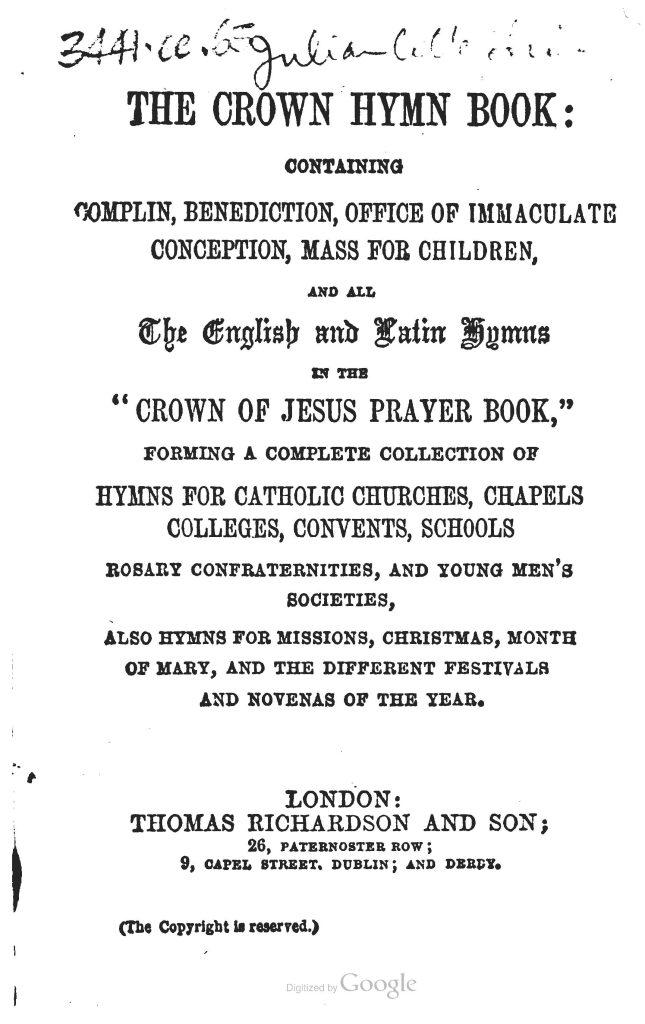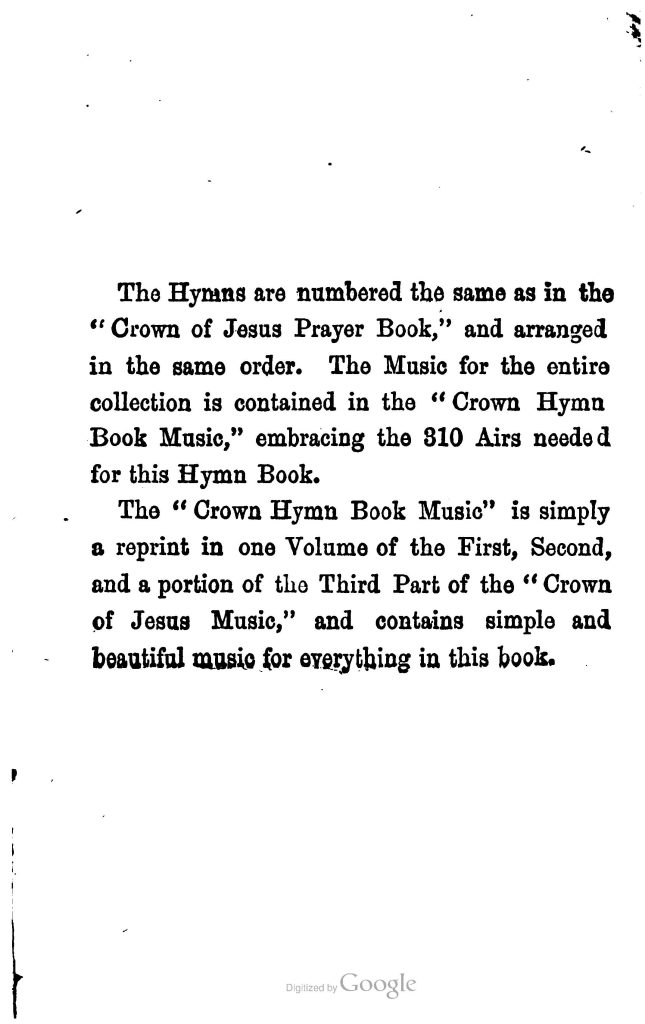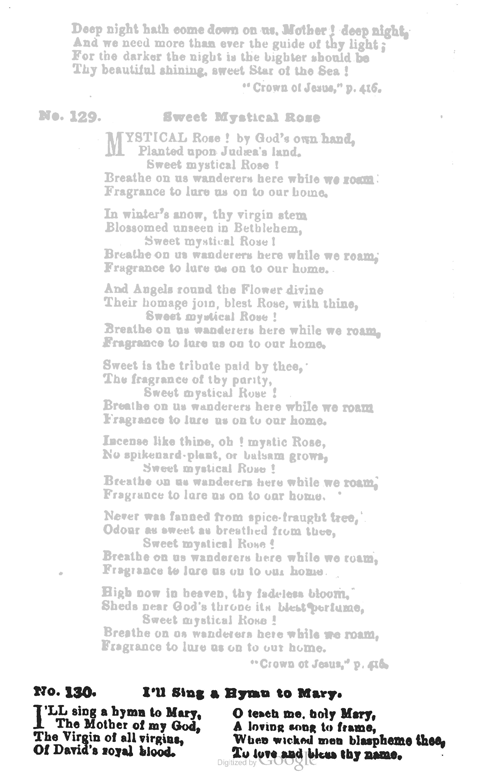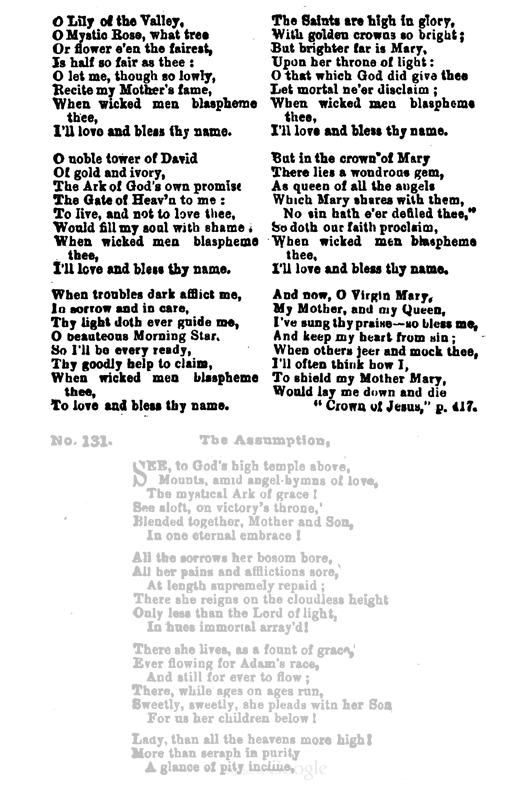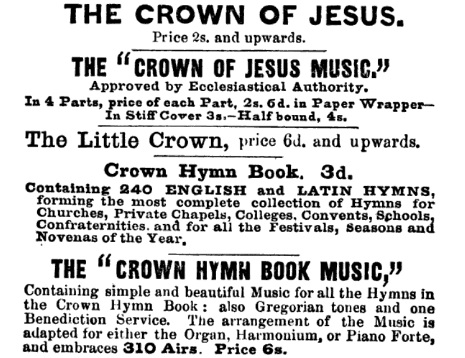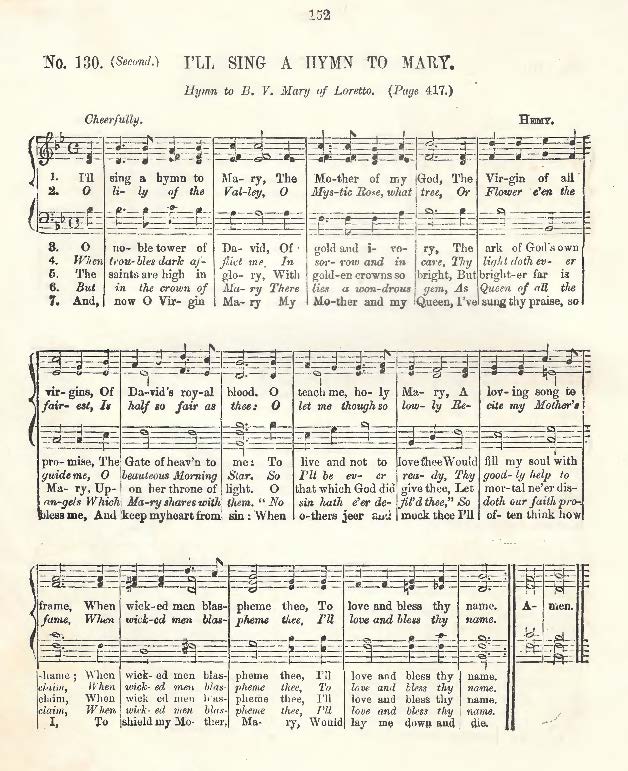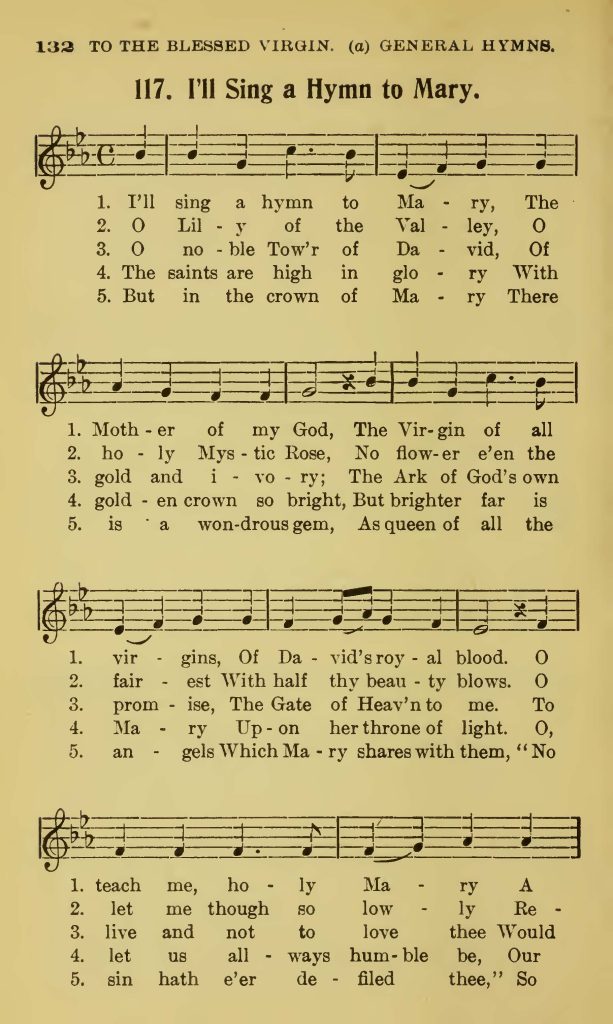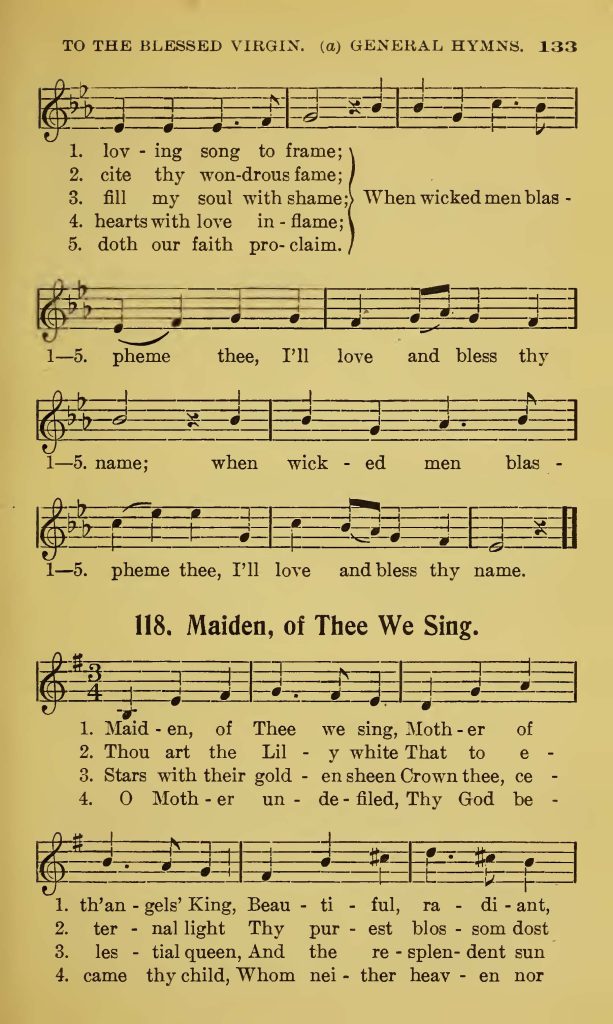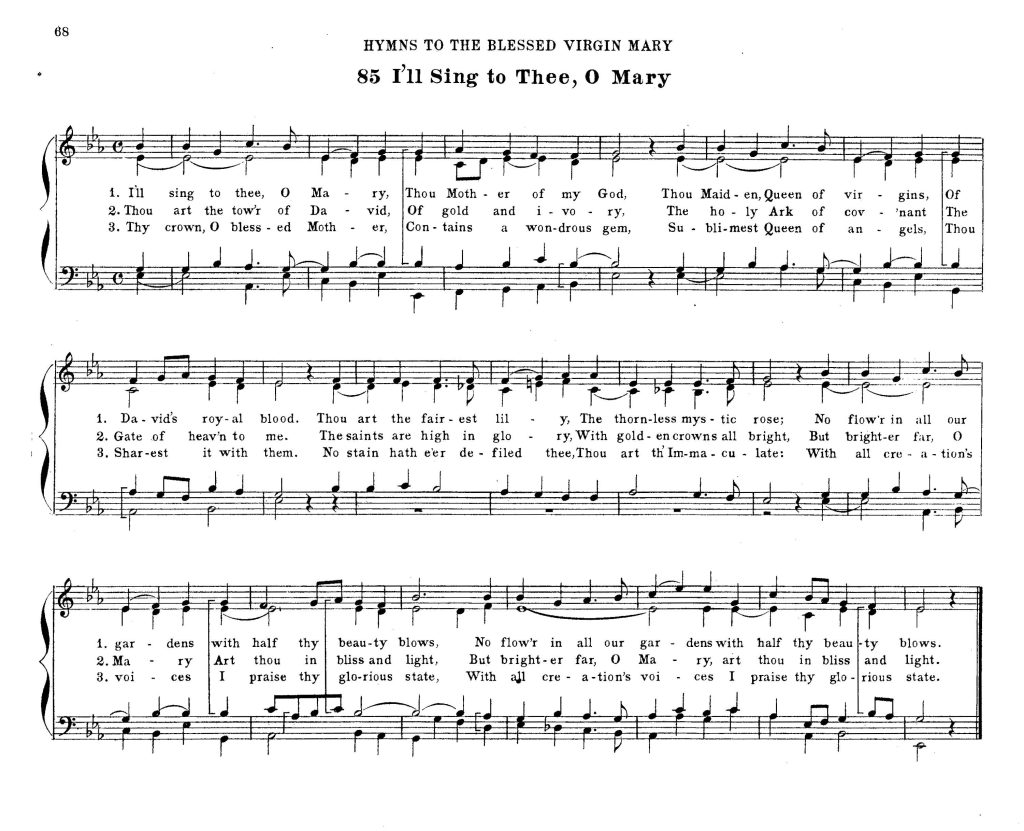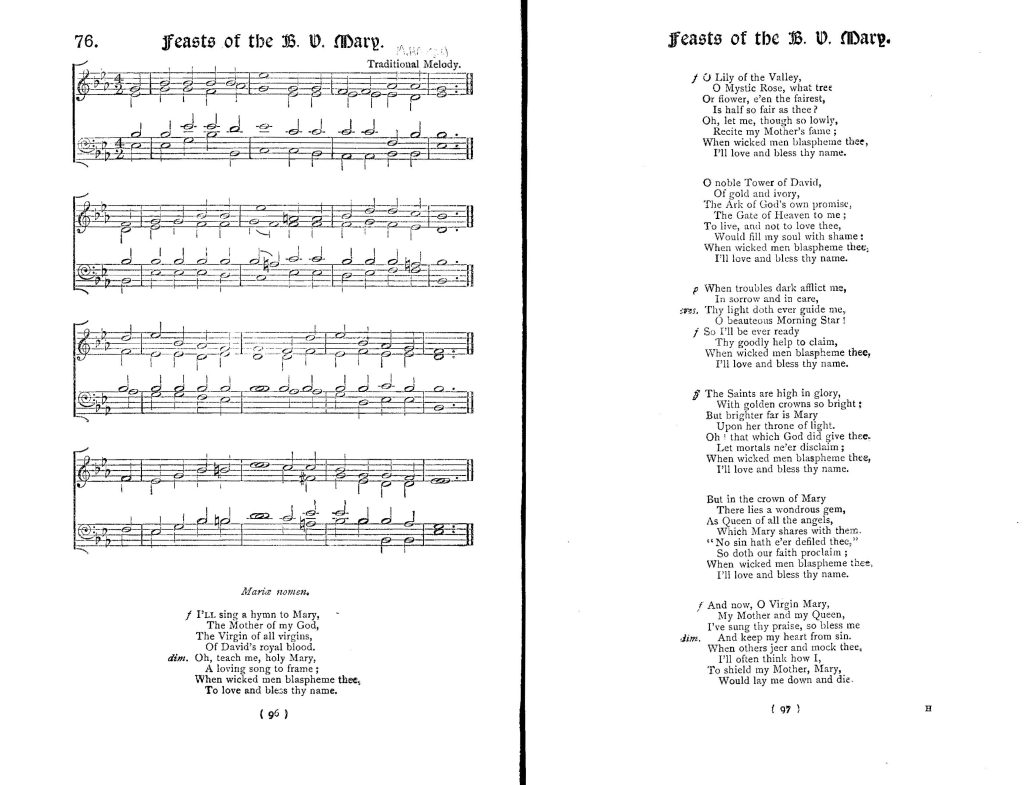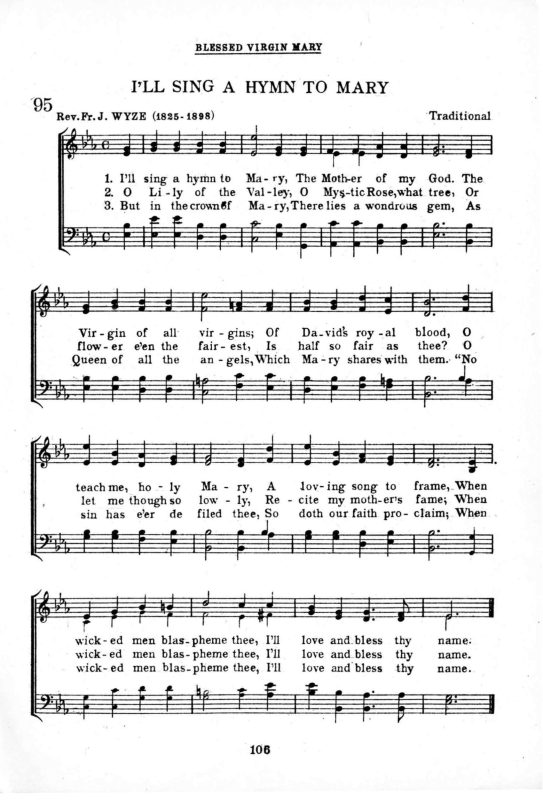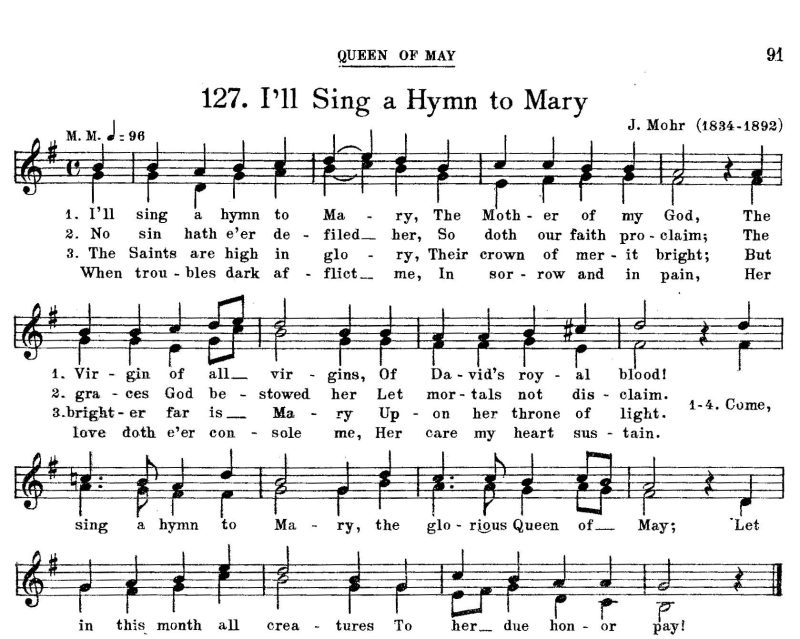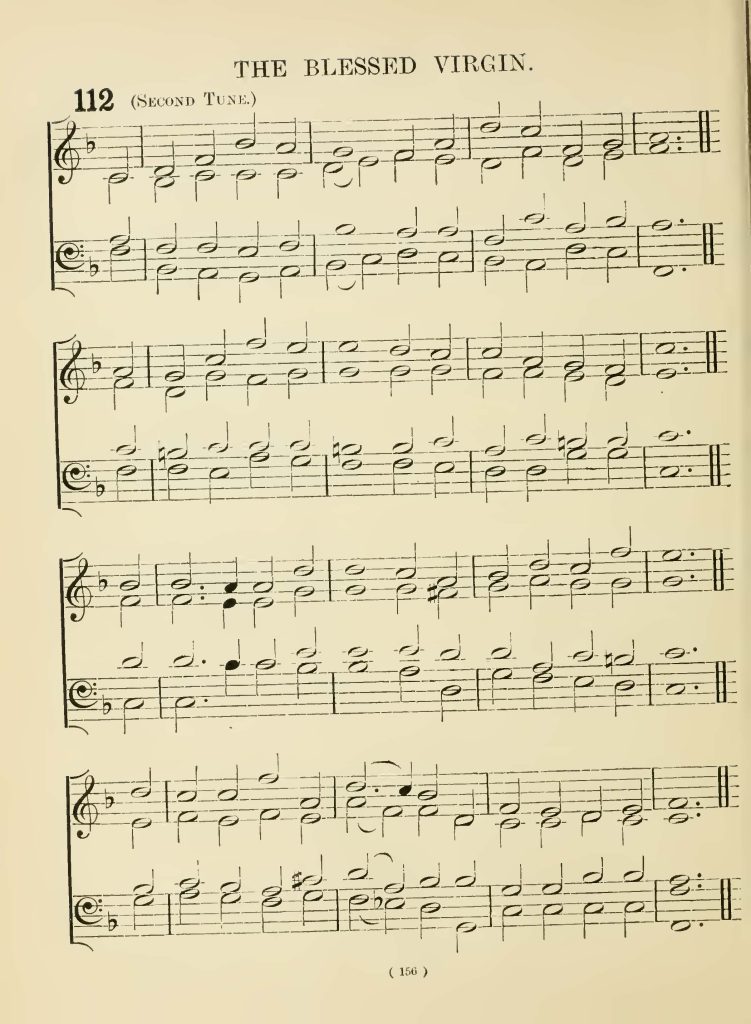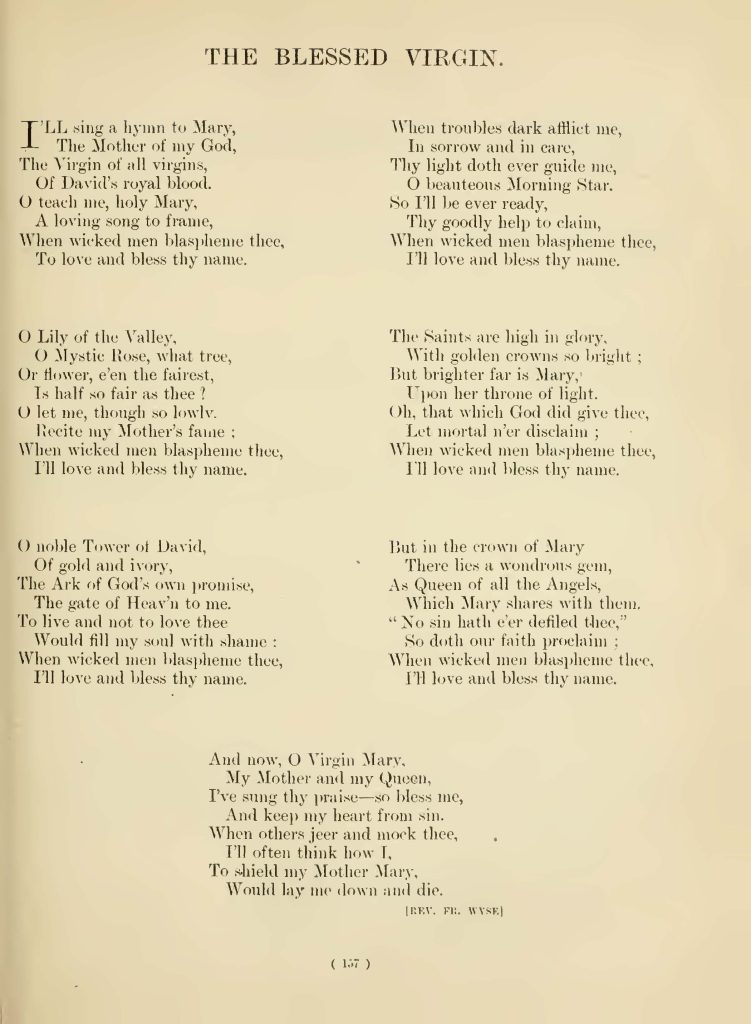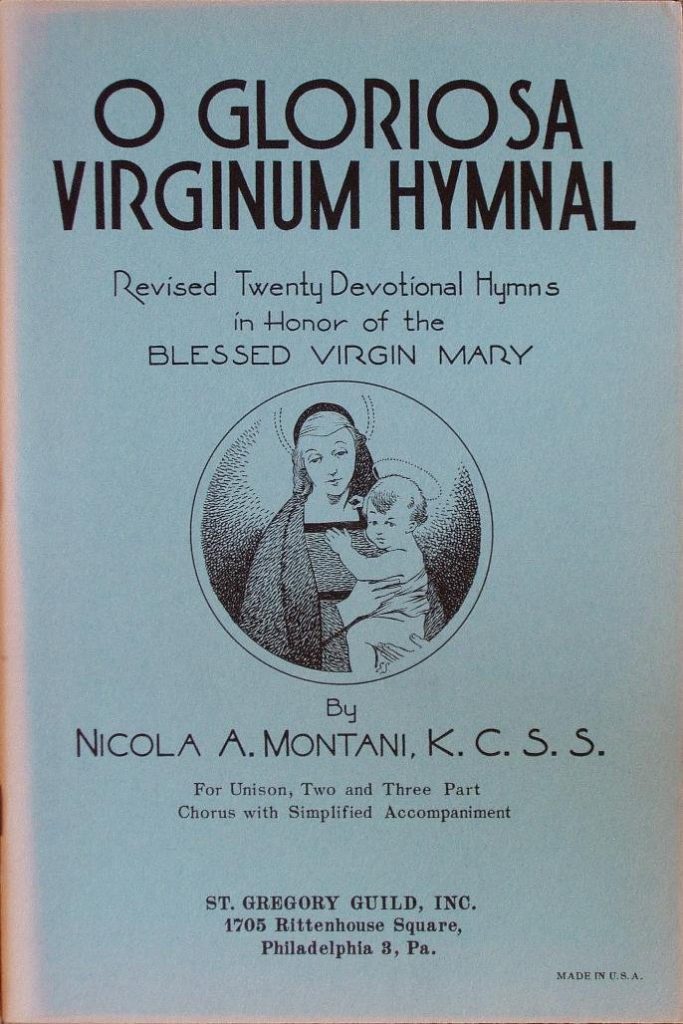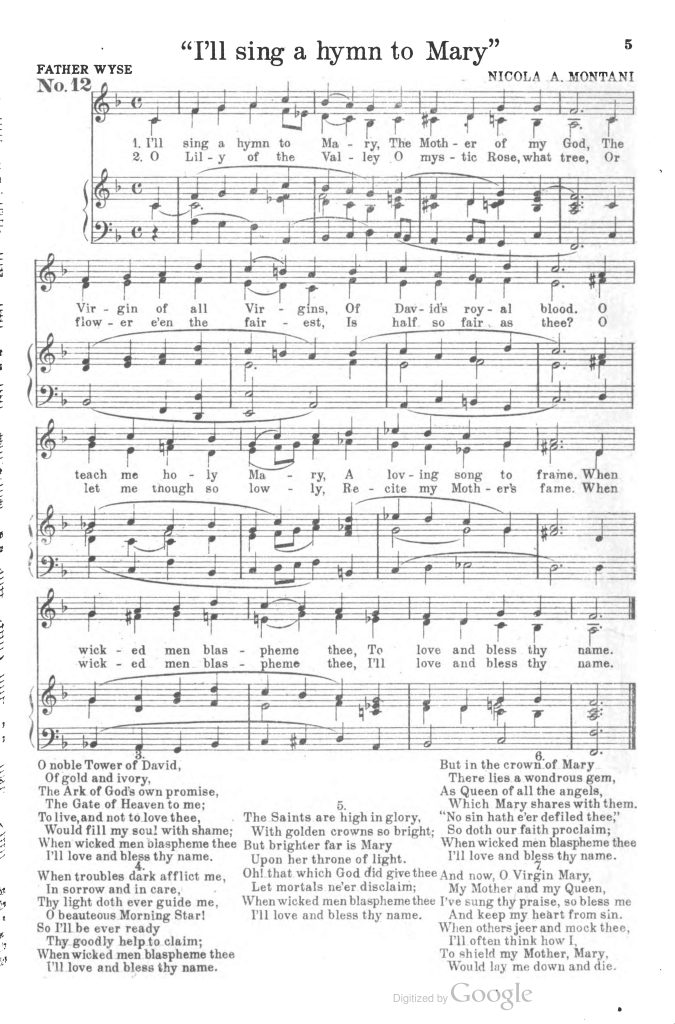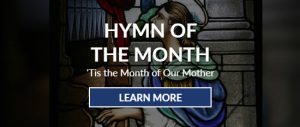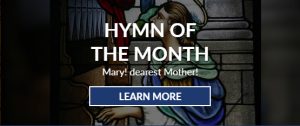Father John Wyse (1825-1898) an Irish Catholic priest wrote the text of this hymn. Little is known about this Catholic priest and hymn writer. He was born in Dublin, Ireland, in 1825 and ordained a Roman Catholic priest in 1851. He served as a parish priest at St Winefride’s, Shepshed from 1852-1853 and in 1884 was pastor of the parish of Tichborne, Hampshire. He died May 22, 1898 while at the Clifton Wood Convent in Bristol, England. The Clifton Wood Convent estate which was run by a religious order of nuns was sold around 1900.
Three other hymns have been attributed to Father Wyse including:
- God the Father, Who Didst Make Me, a hymn to the Holy Trinity.
- From Day-to-Day Sing Loud the Lay, which is a good translation of the Latin Omni Die Dic Marie.
- God Comes to His Altar, a hymn for Holy Communion.
The earliest appearance of the hymn I’ll Sing a Hymn to Mary is found in the CROWN OF JESUS PRAYER BOOK, published in 1862 which was followed by THE CROWN HYMN BOOK published in the same year.
There was a series of THE CROWN OF JESUS publications which included the CROWN OF JESUS PRAYER BOOK, THE CROWN HYMN BOOK, THE CROWN HYMN BOOK MUSIC, and THE CROWN OF JESUS MUSIC. These were all published beginning in 1862 and continued to see publications for several years afterwards including by publisher P. J. Kenedy of New York in 1882.
The first edition of the CROWN OF JESUS MUSIC containing all four parts was published in 1862. However, as can be seen above it was available in separate parts, and this explains why we find page references in parentheses under the hymn names. The CROWN OF JESUS MUSIC editions you find on Google, or the Internet Archive only contain the first three parts and exclude the Gregorian and English Masses. Finding a copy with all four parts is exceedingly rare.
All the music for the CROWN OF JESUS collection was compiled by Henri F. Hemy (1818-1888) one of the great composers of the nineteenth century and best known for his melody for Faith of Our Fathers. Henri was born in 1818 Newcastle, England. He was the organist at St. Andrew’s Church in Newcastle and later professor of music at St. Cuthbert’s College now Ushaw College in Durham. He sang baritone, painted artwork, and composed more than seventy different works of music including his Modern Tutor for Pianoforte, 1858. He also compiled the EASY HYMNS AND SONGS, 1851.
The Melodies
Thirteen melodies have been located for this hymn and they appeared in Catholic hymnals throughout America, England, and Ireland. The most widely used melody was composed by Henri F. Hemy and can be found in the CROWN OF JESUS MUSIC, 1864. This melody appeared in more Catholic hymnals than any other including: the PAROCHIAL HYMN BOOK, (1881 and 1897) compiled by Augustus Edmonds Tozer; the WESTMINSTER HYMNAL, 1912, compiled by Sir Richard Terry; the BOOK OF HYMNS WITH TUNES, 1913 compiled by Dom Samuel Ould, O.S.B.; the CROWN HYMNAL, 1913 compiled by Father Kavanagh and James McLaughlin; the ST. BASIL’s HYMNAL, (1918 thru 1953) compiled by the Basilian Fathers; and the HOLY GHOST HYMNAL, 1954 compiled by the Holy Ghost Fathers, Dublin.h
A second melody which gained some popularity first appeared in the 1901 edition of the PSALLITE compiled by Father Alexander Roesler, S.J., (1875-1904) which list the composer’s name as Benjamin Hamma (1831-1911). Benjamin Hamma compiled the CATHOLIC YOUTH’S HYMNAL, 1891 and made other contributions to Catholic music. When Father Roesler died, Father Ludwig Bonvin, S.J., (1850-1930) became the editor, he altered various hymn texts, added some new tunes, and issued a revised collection as HOSANNA, 1910. The PSALLITE continued to be published as a separate collection until twelfth edition in 1925. The same melody appeared in THE PARISH HYMNAL, 1915 compiled by Joseph Otten (1852-1926). Joseph Otten was hunchback who came from Holland to Canada. When he was in his early twenties, he moved to St. Paul’s Cathedral in the Diocese of Pittsburgh Pennsylvania where he was the organist until his death. Other hymnals include: the CATHOLIC HYMNAL, 1920 compiled by Father John G. Hacker, S.J., (1877-1946), and the PAROCHIAL HYMNAL, 1951 compiled by Father Carlo Rossini (1890-1975).
Michael Haydn (1737-1806) composed a melody, and it is from a Mass, composed for the use of Country Churches. J. Vincent Higginson (1895-1995) (aka Cyr De Brant) in his HANDBOOK FOR AMERICAN CATHOLIC HYMNALS, 1976 he indicates that in Christian Latrobe’s SELECTION OF SACRED MUSIC, 1806, Vol. 1, there are excerpts of the Mass for Country Churches. However, the melody is not present in these excerpts. Michael Haydn composed more than forty Masses for the Catholic Church.
The earliest that the melody composed by Michael Haydn appears in a Catholic hymnal for the hymn I’ll Sing a Hymn to Mary, is in the CATHOLIC HYMNS, 1898, compiled by Augustus Edmonds Tozer and published by Cary & Co., London. The CATHOLIC HYMNS collection by Tozer is a musical edition of the ST. DOMINIC’S HYMN BOOK of 1886; the melody appears later in the CATHOLIC CHURCH HYMNAL, 1905 and 1933, also compiled by Augustus Edmonds Tozer; The NOTRE DAME HYMN TUNE BOOK, 1905 compiled by Frank Birtchnell and Moir Brown and published by the Rockliff Brothers of Liverpool, England; and the STANDARD CATHOLIC HYMNAL, 1921 compiled by James A. Reilly of McLaughlin & Reilly Co., one of the most successful Catholic music publishing companies of the twentieth century.
During the first half of the twentieth century editors began changing the text of the hymn. An example of these alterations can be seen above in the PARISH HYMNAL, 1915 and in the ALVERNO HYMNAL BOOK 3, 1953 below compiled by Sister Mary Cherubim Schaeffer, O.S.F., (1886-1977). The ALVERNO HYMNAL was published in three books. Book 1 – Advent and Christmas (1948); Book 2 – Lent, Holy Week, Easter, and the major Feast Days throughout the year (1950); Book 3 – Hymns for Low Mass (1953). As can be seen in the ALVERNO HYMNAL, the hymn text was altered to favor a May hymn.
These May hymn alterations appeared in the following Catholic hymnals: the PSALLITE, 1901, compiled by Father Alexander Roesler, S.J.; the 1925 and 1932 CANTATE, compiled by John Singenberger (1848-1924); the ST. MARY’S MANUAL, 1924 compiled by Christian A. Zitell an organist for fifty years at St. Mary’s, a Jesuit Church in Toledo, Ohio; and the ST. ROSE HYMNAL, 1940 compiled by the Sisters of St. Francis of the Perpetual Adoration of La Crosse, Wisconsin. Father Joseph Mohr, S.J., (1834-1892) composed the melody.
Sir Richard R. Terry (1865-1938) composed a melody which appeared in the WESTMINSTER HYMNAL, 1912. Sir Richard was educated at Cambridge and became a convert to Catholicism in 1896. He was the choirmaster and organist at the Westminster Catholic Cathedral for over twenty years, and was knighted in 1922.
In the April 1919 edition of the CATHOLIC CHOIRMASTER, a bulletin published by the Society of St. Gregory and edited by Nicola A. Montani, sole owner of the St. Gregory Guild, there is an advertisement for a collection of TWENTY DEVOTIONAL HYMNS published by the Theodore Presser Co., This insert contains a sample of the hymns including I’ll Sing a Hymn to Mary with a melody composed by Nicola A. Montani. This collection was originally published around 1914 but was revised and the title changed to the O GLORIOSA VIRGINUM HYMNAL in 1951.
Other melodies were composed for I’ll Sing a Hymn to Mary, but they did not achieve any wide usage. They include a melody captioned Greek Air found in the CROWN OF JESUS MUSIC, 1864; a melody composed by E. F. MacGonigle an editor and composer of the late 19th century who compiled the SODALIST HYMNAL, 1887; a Marist brother known only as B.F.B., found in the AMERICAN CATHOLIC HYMNAL, 1913; a melody by DOM Anselm Schubiger, O.S.B. (1815-1888) found in the DIOCESAN HYMNAL PART 2, 1928 compiled by Cleveland Ohio Bishop Schrembs; a composition by Johann Crüger (1598-1662) found in the WESTMINSTER HYMNAL, 1939 and the ST. PAUL HYMNAL, 2015 published by the St. Paul’s Choir School of Cambridge, Massachusetts; a melody by Robert de Pearsall (1795-1856) that appeared in the MEDIATOR DEI HYMNAL, 1955; and an anonymous melody of German origin found in the NEW ST. BASIL HYMNAL, 1958.
Reflection
This is a wonderful hymn to sing and very appropriate for the Feast of the Solemnity of Mary, Mother of God. It’s also very appropriate any time we wish to honor Our Blessed Mother because when we honor her, we magnify the Lord!
When I reflect on the verses, I can see allusions to passages from the bible. In the first verse, I am reminded of the gospel account in Luke 1:27-28 and a reference to Isaiah 7:14. I’ll sing a hymn to Mary, the Mother of my God, the virgin of all virgins, of David’s royal blood. In all the verses, I see some of the most famous titles given to Our Blessed Mother including Mother of God; Virgin of all Virgins; O Lily of the valley; O Mystic Rose; Queen of all Angels, and My Mother and my Queen.
These titles are taken from the Litany of the Blessed Virgin Mary and so when we sing this hymn, we are in a sense singing this beautiful Litany. I also see an allusion to Luke 1:46-55 in the phrase, O teach me Holy Mary, a loving song to frame. When I reflect on the last phrase of the verse, I’ll love and bless thy name, I am reminded again of the Magnificat in Luke’s gospel, 1:48, For he has looked upon his servant in her lowliness; all ages to come shall call me blessed.
Anyone who meditates on these verses will see something different or nothing at all.
What can you see?
Below is a selection of the melodies described above. These are computer generated sound files. The tempo is approximate but should provide the listener a good sense of what the hymn sounds like. All the hymns are in the public domain.
The Devotional Hymns Project, produced by Peter Meggison, includes a recording of this hymn used with the permission of the Schola Cantorum of the Cardinal Vaughan Memorial School in London.

